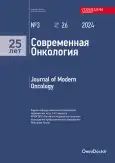Increasing the effectiveness of total-skin electron beam therapy by reducing the manifestations of radiation dermatitis in patients with primary lymphomas. A comparative randomized prospective study
- 作者: Zelianina M.I.1, Vinogradova Y.N.1, Zaslavskiy D.V.2, Gilvanova E.V.1, Ilyin N.V.1
-
隶属关系:
- Granov Russian Research Center of Radiology and Surgical Technologies
- Saint Petersburg State Pediatric Medical University
- 期: 卷 26, 编号 3 (2024)
- 页面: 317-322
- 栏目: Articles
- URL: https://journals.rcsi.science/1815-1434/article/view/275824
- DOI: https://doi.org/10.26442/18151434.2024.3.202898
- ID: 275824
如何引用文章
全文:
详细
Background. One of the main adverse events that significantly reduce the quality of life of patients and limit the total focal dose is radiation-induced skin reactions (RISR). Their timely diagnosis, prevention, and treatment remain urgent tasks of modern radiotherapy.
Aim. To improve the effectiveness of total skin irradiation (TSI) in patients with primary skin lymphomas by reducing the clinical manifestations of RISR by using additional therapy with a hydrogel containing active components with vasoprotective and anti-inflammatory action.
Materials and methods. A comparative randomized prospective study was conducted, including data from 52 patients who received electron TSI by conventional fractionation at a total focal dose of 14 to 30 Gy for primary cutaneous lymphomas at the Granov Russian Research Center of Radiology and Surgical Technologies from September 2021 to January 2024. Before the first TSI session, during treatment and 2 weeks after the end of radiation therapy, all patients underwent assessment for RISR, quantitative assessment of various degrees of severity of radiodermatitis using instrumental methods and assessment scales; for the observation group, a therapeutic regimen for the prevention and treatment of RISR was used, including a hydrogel with troxerutin (2%) and trolamine (0.07%), and in the control group, basic skin care using moisturizers.
Results. Analysis of the physiological parameters of the skin showed statistically significant differences between the study groups: patients of the study group (group I; 30 subjects receiving the above-mentioned therapeutic regimen) compared with the control group (group II; 28 subjects who did not receive specific treatment for radiodermatitis) reported significantly lower rates of erythema (386±12.3 and 572±14.4; p=0.005), transepidermal water loss (25±0.3 and 38±0.4 g/m2/h; p<0.001) and a decrease in peak endothelial-dependent vasodilation of microvasculature and blood flow in the skin. A lower proportion of severe radiodermatitis (86.3 and 73.3%; p<0.05) and a statistically significant difference in the subjective quality of life scores by the 29-point Skindex-29 scale by an average of 22.2% were also found.
Conclusion. A comparative analysis of the quantitative indicators of radiodermatitis in the study group and the control group showed that the topical application of the hydrocolloid gel containing troxerutin and trolamine reduces the clinical manifestations of RISR concerning objectively measured physiological parameters of the skin and blood flow parameters of the microvasculature measured by high-frequency ultrasound, thus improving the quality of life of patients during and after the course of radiation therapy.
作者简介
Maria Zelianina
Granov Russian Research Center of Radiology and Surgical Technologies
编辑信件的主要联系方式.
Email: m.zelianina@rambler.ru
ORCID iD: 0000-0002-0172-9763
SPIN 代码: 3201-9685
Graduate Student
俄罗斯联邦, Saint PetersburgYulia Vinogradova
Granov Russian Research Center of Radiology and Surgical Technologies
Email: winogradova68@mail.ru
ORCID iD: 0000-0002-0938-5213
SPIN 代码: 8876-8936
D. Sci. (Med.), Assoc. Prof.
俄罗斯联邦, Saint PetersburgDenis Zaslavskiy
Saint Petersburg State Pediatric Medical University
Email: venerology@gmail.com
SPIN 代码: 5832-9510
D. Sci. (Med.), Prof.
俄罗斯联邦, Saint PetersburgElina Gilvanova
Granov Russian Research Center of Radiology and Surgical Technologies
Email: masiuka1@yandex.ru
Graduate Student
俄罗斯联邦, Saint PetersburgNikolay Ilyin
Granov Russian Research Center of Radiology and Surgical Technologies
Email: ilyin_prof@mail.ru
SPIN 代码: 2242-2112
D. Sci. (Med.), Prof.
俄罗斯联邦, Saint Petersburg参考
- Hegedus F, Mathew LM, Schwartz RA. Radiation dermatitis: an overview. Int J Dermatol. 2017;56(9):909-14. doi: 10.1111/ijd.13371
- Finkelstein S, Kanee L, Behroozian T, et al. Comparison of clinical practice guidelines on radiation dermatitis: a narrative review. Support Care Cancer. 2022;30(6):4663-74. doi: 10.1007/s00520-022-06829-6
- Paudyal P, Apfelbacher C, Jones C, et al. DLQI seems to be ‘action’, and Skindex-29 seems to be ‘emotion’: qualitative study of the perceptions of patients with psoriasis or eczema on two common dermatology-specific quality of life measures. Acta Derm Venereol. 2020;100(8):adv00105. doi: 10.2340/00015555-3417
- CTCAE v6.0 Solicitation of Changes Brief Overview. Available at: ctep.cancer.gov/protocoldevelopment/electronic_applications/docs/CTCAE_v6_Solicitation_Brief_Overview.pdf. Accessed: 26.01.2024.
- Pires AM, Segreto RA, Segreto HR, et al. RTOG criteria to evaluate acute skin reaction and its risk factors in patients with breast cancer submitted to radiotherapy. Rev Lat Am Enfermagem. 2008;1(5):844-9. doi: 10.1590/s0104-11692008000500008
- Kitajima M, Mikami K, Noto Y, et al. Quantitative assessment of radiodermatitis through a non-invasive objective procedure in patients with breast cancer. Mol Clin Oncol. 2020;12(1):89-93. doi: 10.3892/mco.2019.1948
- Chen W, Lu W, Yuan Y, et al. The role of ultrasound quantitative parameters in the assessment of acute radiodermatitis after breast-conserving surgery. J Radiat Res. 2023;64(3):574-81. doi: 10.1093/jrr/rrad029
- Rosenthal A, Israilevich R, Moy R. Management of acute radiation dermatitis: a review of the literature and proposal for treatment algorithm. J Am Acad Dermatol. 2019;81(2):558-67. doi: 10.1016/j.jaad.2019.02.047
- Panat NA, Maurya DK, Ghaskadbi SS, Sandur SK. Troxerutin, a plant flavonoid, protects cells against oxidative stress-induced cell death through radical scavenging mechanism. Food Chem. 2016;194:32-45. doi: 10.1016/j.foodchem.2015.07.078
- Zamanian M, Bazmandegan G, Sureda A, et al. The protective roles and molecular mechanisms of troxerutin (vitamin P4) for the treatment of chronic diseases: A mechanistic review. Curr Neuropharmacol. 2021;19(1):97-110. doi: 10.2174/1570159X18666200510020744
- Ahmadi Z, Mohammadinejad R, Roomiani S, et al. Biological and therapeutic effects of troxerutin: molecular signaling pathways come into view. J Pharmacopuncture. 2021;24(1):1. doi: 10.3831/KPI.2021.24.1.1
- Abbas H, Bensadoun RJ. Trolamine emulsion for the prevention of radiation dermatitis in patients with squamous cell carcinoma of the head and neck. Support Care Cancer. 2012;20(1):185-90. doi: 10.1007/s00520-011-1110-3
- Yong HI, Kim TK, Jung S, Kim YB, et al. Quality of reduced-fat meat emulsion: Effect of pre-emulsified duck skin and hydrocolloids. J Food Sci Technol. 2021;58:1238-46. doi: 10.1007/s13197-020-04633-w
补充文件










